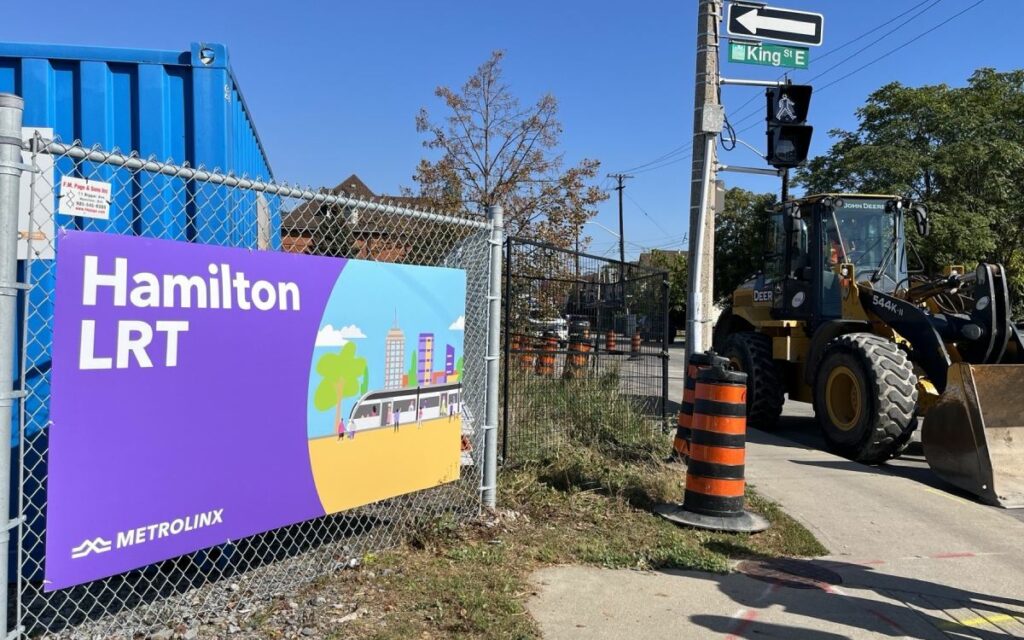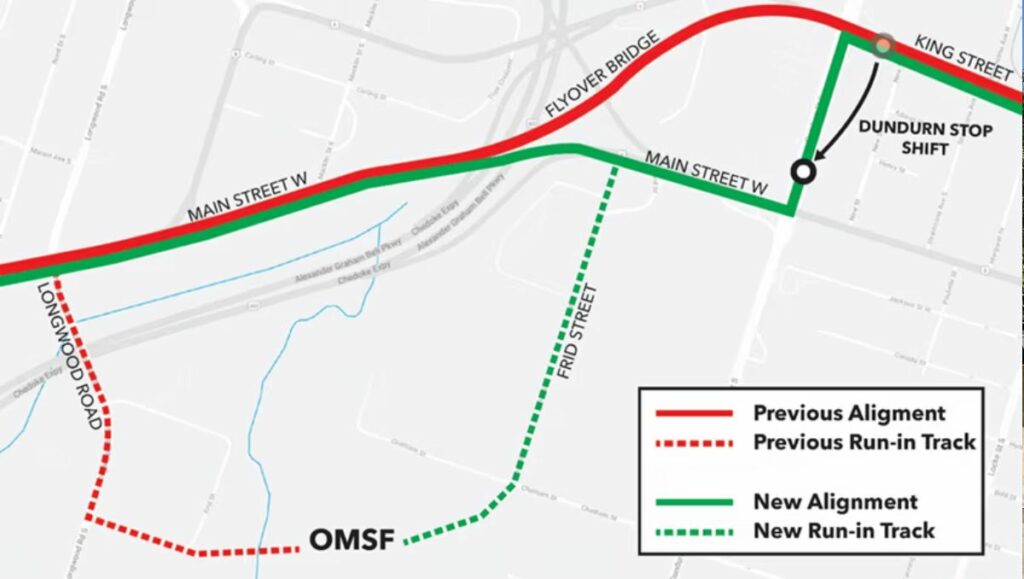
Photo: Facebook/Hamilton LRT
A few days ago, Metrolinx provided an update on their planned light rail transit (LRT) line that will be built in Hamilton, announcing that they are proposing a slight route change.
The portion in question involves figuring out the best way for the LRT to cross Highway 403 as it approaches McMaster University and how to get trains to the planned Operations, Maintenance and Storage (OMS) facility on Chatham Street by McMaster Innovation Park.
The original plan was for the LRT to follow King Street West over Highway 403 via the same route as the Flyover Bridge, which passes directly beside Hamilton’s Cathedral Basilica of Christ the King.
Previously, a new LRT-only bridge was going to be built alongside the Flyover Bridge so that the train could get over the highway.
Additionally, a “run-in track” from the regular LRT route to the OMS facility was set to cross run south down Longwood Road, passing McMaster Innovation Park before turning east towards its destination.
However, Metrolinx now says that due to Council’s decision to convert Main Street to two-way traffic, it makes more sense for the LRT to head south on Dundurn from King Street to Main Street and then follow Main Street across the 403.
Additionally, as for the “run-in track” to the OMS facility, Metrolinx says that it makes more sense for the route to simply head south directly down Frid Street from Main all the way to Chatham Street.

Map of previous and new alignment
The new route would also see the LRT’s Dundurn stop shift from King at Dundurn to Dundurn at Main.
Metrolinx indicates that the route change will save the project time and money since the LRT-only bridge over the 403 via King Street and the reconstruction of the Longwood Road bridge will not be required for the project.
Metrolinx also suggests that the new route is more environmentally friendly since the route across the 403 via King Street would have meant cutting into park space at Cathedral Park, located behind the Fortinos plaza.
As a result of the route change, Metrolinx noted four additional benefits.
First, Metrolinx states that the route refinement will see the reconstruction of the Main Street bridge over Highway 403, enabling future highway widening.
Second, it will mean the reconstruction of the part of the Main Street bridge that crosses over existing Canadian Pacific Railway tracks, a portion of the bridge which is “currently at the end of its lifecycle.”
Third, it will allow the reconstruction of Highway 403 ramps, enabling the two-way conversion of Main Street.
Fourth, it will mean the total reconstruction of Frid Street, including full roadway and utility replacement.
The plan would likely also involve the total reimagination of Dundurn Street between Main and King, likely with biking infrastructure.
Perhaps most importantly, however will be the potential cost savings, with serious questions already being asked about the project coming in over the $3.4 billion in funding set aside by the federal and provincial governments.
With the cost of just about everything on the rise, it remains to be seen how much the new route change will save taxpayers as well as the final price tag of the project as a whole.
Metrolinx notes that Hamiltonians will see the first shovels in the ground on Wentworth Street, Sherman Avenue, and Nash Road as crews begin relocating water mains, which is necessary for more significant construction to take place.
Metrolinx will also be hosting a “Hamilton LRT Virtual Event” on Thursday, November 30, at 6:30 PM to allow Hamiltonians to “learn more about the Hamilton LRT project and the new design refinement.”
Attendees can register here on the Metrolinx’s Hamilton LRT webpage.

Based in Hamilton, he reaches hundreds of thousands of people monthly on Facebook, Instagram, TikTok, and Twitter. He has been published in The Hamilton Spectator, Stoney Creek News, and Bay Observer. He has also been a segment host with Cable 14 Hamilton. In 2017, he received the Chancellor Full Tuition Scholarship from the University of Ottawa (BA, 2022). He has also received the Governor General’s Academic Medal. He formerly worked in a non-partisan role on Parliament Hill in Ottawa.






